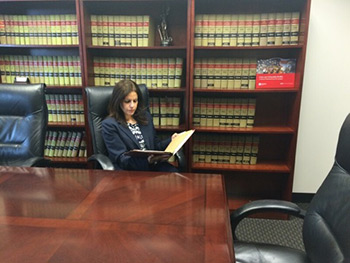Description
If a migrant living abroad would like to temporarily enter the United States for educational purposes, the migrant must apply for a student visa. There are two (2) main types of student visas (F-1 and M-1) that are applied from abroad at a U.S. Embassy or Consulate. Certain factors pertain to each type of visa, and they are as follows:
The F-1 nonimmigrant visa is generally issued to ‘academic’ students. This visa category allows a migrant to enter the United States and attend an accredited college, university, high school, elementary school, seminary, conservatory, or other academic institution in a language training program. The school must be accredited to receive and enroll international students under the Student and Exchange Visitors Program (SEVP).
The M-1 nonimmigrant visa is generally issued to ‘vocational’ students. This visa category allows a migrant to enter the United States to pursue a course of study in vocational institutions, technical schools, or other nonacademic programs, other than language training. An M-1 visa is ideal for any migrant interested in pursuing courses in mechanics, cosmetology, aviation, cooking, etc. Under an M-1 visa, a student is only allowed to remain in the United States for up to one (1) year or the time necessary to complete the nonacademic program.
Regardless of the visa category of interest, the migrant must comply with certain requirements to meet eligibility. Therefore, a migrant must demonstrate evidence of residence abroad and sufficient financial funds to cover the cost of tuition and cost of living in the United States. Since the migrant is required to return to his or her country of origin upon termination of any authorized stay, the migrant may not seek any federal financial aid. Additionally, the migrant must demonstrate accepted full-time enrollment at an educational entity approved by SEVP and Immigration and Customs. Generally, a migrant pursuing a course of study is required to be proficient in English or be enrolled in any language course that will contribute to his or her English proficiency.
Regardless of the student visa of, F-1 or M-1, the migrant must apply at the U.S. Embassy or Consulate by submitting an electronically Form DS-160, Nonimmigrant Visa Application. Upon electronically submission, the migrant must follow the instructions for scheduling an appointment with the U.S. Embassy or Consulate. Additionally, the migrant must gather the required documentation to present at the scheduled interview. An interview approval will generate the issuance of an F-1 or M-1 visa on the migrant’s passport and will register a lawful admission to the United States at port of entry.
Benefits
Although F-1 and M-1 visas are issued for educational purposes, they may also offer students limited ability to seek employment opportunities. An F-1 and M-1 student may be eligible to accept on-campus employment during the first academic year as long as it meets certain criteria. Therefore, any on-campus employment must not exceed 20 hours per week while school is in session. However, after the first academic year an F-1 student may seek authorization in any of the three types of off-campus employment: Curricular Practical Training (CPT), Optional Practical Training (OPT), pre- or post-completion, or Science, Technology, Engineering, and Mathematics (STEM) Optical Training Extension (OPT). However, M-1 students may only engage in practical training after completion of studies.
Migrants who are granted authorization for employment under OPT must have an approved Form I-20, Certificate of Eligibility for Nonimmigrant Student Status. This opportunity allows F-1 students to obtain real-world experience in a field of study. Although there are employment restrictions, an F-1 student may be exempt and be eligible for off-campus employment if he or she is undergoing severe financial hardship. Each case is evaluated independently and requires prior authorization.
In addition to limited employment opportunities, an F-1 and M-1 student can extend its lawful immigration status in the United States to eligible dependents, spouse, and unmarried minor children. Dependents will be granted corresponding F-1 or M-2 visas throughout the student’s program of study and any authorized period of OPT. However, upon completion of study and/or authorized OPT, the dependents must return to their country of origin to avoid unlawful presence in the United States.
Derivative Dependents
Spouses and dependent children of potential F-1 students must register in the SEVIS system. SEVP approved school will issue spouses and dependent children each their own Form I-20 to present at their U.S. Consulate interview. However, spouses and dependents of F-1 students do not need to pay the SEVIS fee.
Process Description
The process of applying for a student visa may vary depending on the processing times of the corresponding U.S. Embassy or Consulate. Generally, to start the process, the migrant must first apply for admission at a school that has been approved by SEVP. Once SEVP accepts the enrollment, the migrant must register for the Student and Exchange Visitor Information System (SEVIS) and pay its associated SEVIS I-901 fee. This process will generate the issuance of Form I-20, which will be required to present at a later time. Any dependent is also required to follow the same procedures by registering in the SEVIS system and waiving any applicable fees to obtain independent I-20 forms.
Once the initial registration/enrollment phase is complete, the migrant may initiate the process before the U.S. Embassy or Consulate by submitting Form DS-160. Each agency may require country-based documentation to secure an in-person interview. Unfortunately, current case processing of student visas varies by agency and country.
Unfavorable Circumstances
Obtaining a student visa is a complex process to navigate through due to the strict eligibility requirements and procedures required to comply with U.S embassies or Consulates and corresponding educational entities. A migrant must be diligent to meet any required deadlines associated with the registration and enrollment process at a U.S. educational entity. Failure to obtain official acceptance will negatively impact eligibility and prolong any processing time.
Additionally, a migrant’s criminal history resulting from any previous felony conviction and/or immigration history resulting from nonimmigrant visa violations required legal assessment by a licensed attorney to determine eligibility.
Most colleges and/or universities in the United States have a higher tuition rate for foreign/international students, which is an unfavorable circumstance as the migrant under F-1 visa status must provide evidence of self-sufficient financial support to cover full tuition, housing, and cost of living in the United States.
Relevant Links List
| Name | Description | Website |
| Student Visa | Website contains additional information regarding the U.S. Department of State student visa process. | https://travel.state.gov/content/travel/en/us-visas/study/student-visa.html |
| Student and Employment | Website contains additional information regarding the U.S. Citizenship and Immigration Services student visa process. | https://www.uscis.gov/working-in-the-united-states/students-and-exchange-visitors/students-and-employment |
Citations
A student visa process is adjudicated under complex and strict eligibility requirements. Certain relevant laws and regulations are specified under the Immigration and Nationality Act (INA), Code of Federal Regulations (CFR) and/or U.S. Code. Some of the applicable laws and regulations include:
Citations List
| Citations | Description | Section Title |
| INA § 101(a)(15)(F) | Immigration and Nationality Act (INA) is a federal law that establishes immigration, naturalization, and exclusion of aliens. | Definitions |
| INA § 101(a)(15)(M) | Immigration and Nationality Act (INA) is a federal law that establishes immigration, naturalization, and exclusion of aliens. | Definitions |
| 9 FAM 402.5 | The Foreign Affairs Manual (FAM) contains directives and guidance associated with the adjudication of U.S. visas. | Students and Exchange Visitors |
Related Forms List
| Name | Description | No. | Fee |
| I-901 SEVIS Fee | This fee is only required post receipt of Form I-20 and is required to verify compliance with congress’ mandate to fund the Student and Exchange Visitor Program (SEVP). | I-901 SEVIS | $350 |
| Online Nonimmigrant Visa Application | This electronic form is only accessible via the Consular Electronic Application Center website. | DS-160 | $0 |
Supporting Documents
Once the migrant wishing to enter as an F-1 student has been admitted/enrolled with an SEVP approved school and has registered and paid the I-901 fee, they may start their visa process. The first step is to create an account with the https://ceac.state.gov/genniv/.
For F-1 visas the migrant must electronically fill out and submit a DS-160 for nonimmigrant visas. After, submitting the DS-160 application the migrant must follow instructions on how to schedule a U.S. Embassy appointment in the country that they reside in. Each U.S. Embassy has their own specific list of required documentation to present prior to the visa interview or to submit at the interview itself. Examples of supporting documentation requested by the U.S. Embassy/U.S. Consulate may be as follows:
Supporting Documents List
| Name | Description |
| Passport-Style Photographs | To include passport-style photograph to be uploaded electronically during the completion of Form DS-160. Photograph must comply with the U.S. Department of State – Bureau of Consular Affairs which requirements vary by country. |
| Personal Documentation | To include birth certificate and passport (valid for at least 6 months beyond the period of stay in the U.S. All documentation must be in compliance with the U.S. Department of State – Bureau of Consular Affairs which requirements vary by country. |
| Verification of Current Marriage | To include a marriage certificate. |
| Proof of Previous Marriage(s) Termination | To include divorce certificate. |
| Proof of Birth for Dependents | To include birth certificates for all children under the age of 21 years old regardless of biological, adoptive, or stepparent relationship. |
| Proof of Educational Institution Acceptance | To include Form I-20, Certificate of Eligibility for Nonimmigrant Student Status, to be provided by institution. |
| SEVIS Payment Confirmation | To include a copy of Form I-901 SEVIS fee confirmation page. |
| Visa Application Confirmation | To include a copy of Form DS-160 barcode page upon electronic submission via the Consular Electronic Application Center website. |
| Application Payment Confirmation | To include a receipt of required visa application fees prior to consular interview. |
| Proof of Academic Background | To include copies of transcripts, diplomas, certificates as well as standardized test scores required by the U.S. institution. |
| Proof of Financial Stability | To include personal bank statements, property deeds, assets, and all other financial documentation that establishes ability to cover all costs incurred by tuition, housing, and cost of U.S. living during the temporary stay. |
| Proof of Intent to Depart U.S. | To include property titles, rental agreements, employment/business records, and/or sworn affidavits from immediate families that establish permanent residence in country of return. |

